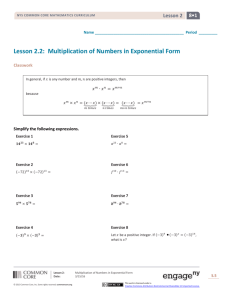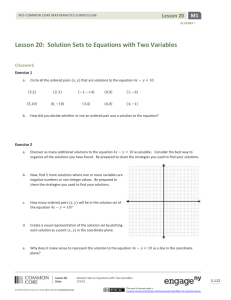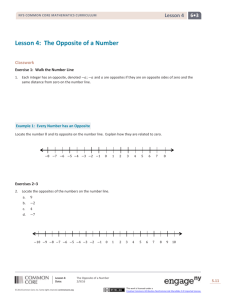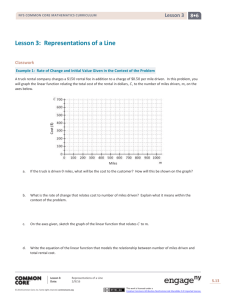1 - Erie 2 Math
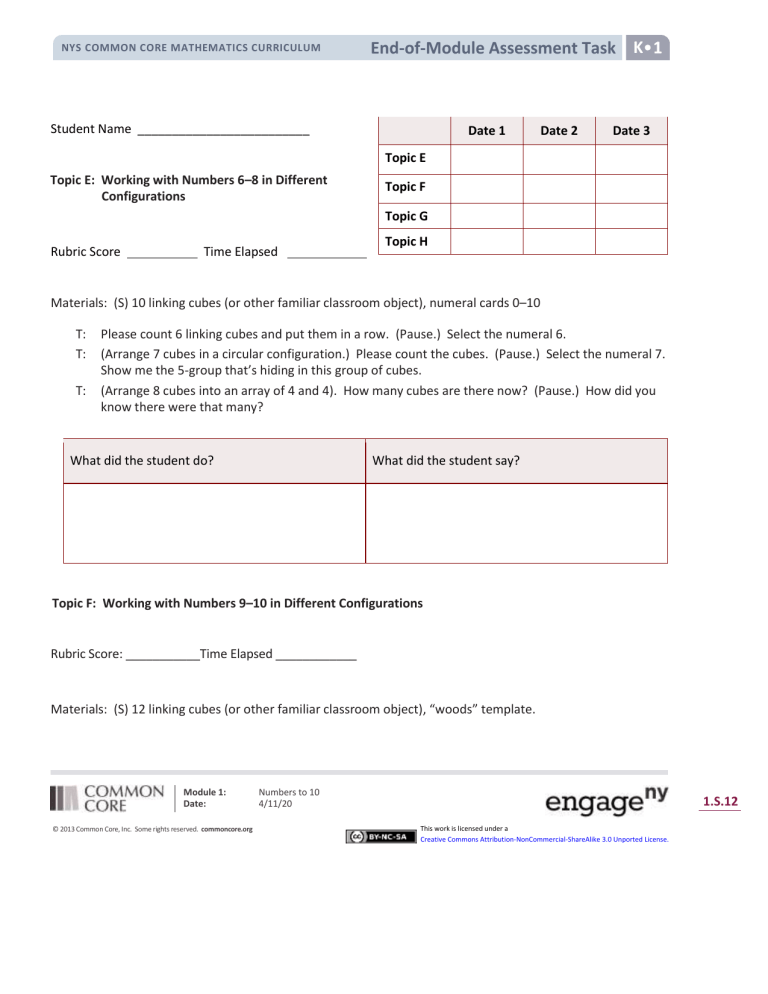
NYS COMMON CORE MATHEMATICS CURRICULUM End-of-Module Assessment Task K
Student Name _________________________
Topic E: Working with Numbers 6–8 in Different
Configurations
Rubric Score Time Elapsed
Topic E
Topic F
Topic G
Topic H
Date 1 Date 2 Date 3
Materials: (S) 10 linking cubes (or other familiar classroom object), numeral cards 0–10
T: Please count 6 linking cubes and put them in a row. (Pause.) Select the numeral 6.
T: (Arrange 7 cubes in a circular configuration.) Please count the cubes. (Pause.) Select the numeral 7.
Show me the 5-group that’s hiding in this group of cubes.
T: (Arrange 8 cubes into an array of 4 and 4). How many cubes are there now? (Pause.) How did you know there were that many?
What did the student do? What did the student say?
Topic F: Working with Numbers 9–10 in Different Configurations
Rubric Score: ___________Time Elapsed ____________
Materials: (S) 12 linking cubes (or other familiar classroom object), “woods” template.
Module 1:
Date:
© 2013 Common Core, Inc. Some rights reserved. commoncore.org
Numbers to 10
4/11/20
This work is licensed under a
Creative Commons Attribution-NonCommercial-ShareAlike 3.0 Unported License.
1.S.12
NYS COMMON CORE MATHEMATICS CURRICULUM End-of-Module Assessment Task K
T: Now let’s pretend these cubes are bears! Show me this problem: There were six bears who were eating leaves here in the woods. (Pause.) Three more bears came over to snack on some leaves.
How many bears were eating leaves in the woods?
T: Use your words to tell me how you figured out the problem.
T: Write the number that tells how many bears there are eating leaves.
T: Another bear came. Show me the bears now. How many bears is that? Write that number.
What did the student do? What did the student say?
Topic G: One More Than with Numbers 0–10
Rubric Score: ___________Time Elapsed ____________
Materials: (T) Numeral cards 7, 8, and 9; dot card showing 4 dots; 10 cubes
T: (Hold up the card showing 4 dots.) Use the materials to show me the number of cubes that is
1 more than this.
T: (Hold up the card showing the numeral 7.) Use the number cards to show me the numeral that’s
1 more. How did you learn that?
T: Put these numeral cards in order from smallest to greatest. (Hand the students the 7, 8 and 9 cards out of order).
What did the student do? What did the student say?
Module 1:
Date:
© 2013 Common Core, Inc. Some rights reserved. commoncore.org
Numbers to 10
4/11/20
This work is licensed under a
Creative Commons Attribution-NonCommercial-ShareAlike 3.0 Unported License.
1.S.13
NYS COMMON CORE MATHEMATICS CURRICULUM End-of-Module Assessment Task K
Topic H: One Less Than with Numbers 0–10
Rubric Score: ___________Time Elapsed ____________
Materials: (T) Numeral and 5-group cards 1–10; 10 counting objects
T: (Place 10 objects in an array of 2 five-groups.) How many objects are there? (Note how the student counts.) Show 1 less. Write how many you have now.
T: (Put the number cards in order from 10 to 1. Turn over the numbers 9, 7, 5, and 2.) Touch and tell me the hidden numbers. Don’t turn over the cards, though!
T: (Place the 9, 7, 5, and 2 dot cards in a line out of order.) Match the dot cards to the hidden numbers.
Turn over the hidden card when you are sure you have matched it.
Module 1:
Date:
© 2013 Common Core, Inc. Some rights reserved. commoncore.org
Numbers to 10
4/11/20
This work is licensed under a
Creative Commons Attribution-NonCommercial-ShareAlike 3.0 Unported License.
1.S.14
NYS COMMON CORE MATHEMATICS CURRICULUM End-of-Module Assessment Task K
End-of-Module Assessment Task
Standards Addressed
Topics E–H
Know number names and the count sequence.
K.CC.3
Write numbers from 0 to 20. Represent a number of objects with a written numeral 0–
20 (with 0 representing a count of no objects).
Count to tell the number of objects.
K.CC.4
Understand the relationship between numbers and quantities; connect counting to cardinality. a. When counting objects, say the number names in the standard order, pairing each object with one and only one number name and each number name with one and only one object. b. Understand that the last number name said tells the number of objects counted.
The number of objects is the same regardless of their arrangement or the order in which they were counted. c. Understand that each successive number name refers to a quantity that is one larger.
K.CC.5
Count to answer “how many?” questions about as many as 20 things arranged in a line, a rectangular array, or a circle, or as many as 10 things in a scattered configuration; given a number from 1–20, count out that many objects.
Evaluating Student Learning Outcomes
A Progression Toward Mastery is provided to describe and quantify steps that illuminate the gradually increasing understandings that students develop on their way to proficiency. In this chart, this progress is presented from left (Step 1) to right (Step 4). The learning goal for each student is to achieve Step 4 mastery.
These steps are meant to help teachers and students identify and celebrate what the student can do now, and what they need to work on next.
Module 1:
Date:
© 2013 Common Core, Inc. Some rights reserved. commoncore.org
Numbers to 10
4/11/20
This work is licensed under a
Creative Commons Attribution-NonCommercial-ShareAlike 3.0 Unported License.
1.S.15
NYS COMMON CORE MATHEMATICS CURRICULUM End-of-Module Assessment Task K
A Progression Toward Mastery
Assessment
Task Item
STEP 1
Little evidence of reasoning without a correct answer.
(1 Point)
STEP 2
Evidence of some reasoning without a correct answer.
(2 Points)
STEP 3
Evidence of some reasoning with a correct answer or evidence of solid reasoning with an incorrect answer.
(3 Points)
Topic E
K.CC.3
K.CC.4a
K.CC.4b
K.CC.5
K.MD.3
STEP 4
Evidence of solid reasoning with a correct answer.
(4 Points)
The student shows little evidence of identifying numerals or
5-groups. Almost nonresponsive.
The student shows evidence of beginning to match numerals to quantities, and to find
5-groups, but is unable to do either consistently.
The student correctly selects each numeral card, but cannot identify the 5-group within each set.
Or, the student identifies the 5-group in each set, but cannot consistently select the corresponding numeral.
The student correctly:
Selects the corresponding numeral that matches the number of cubes.
Identifies the 5group within each set.
Topic F
K.CC.3
K.CC.4a
K.CC.4b
K.CC.5
The student shows little evidence of understanding zero or how to solve put together with result
unknown problems.
The student shows an early understanding of how to solve put together with result
unknown problems, and demonstrates weak explanation skills with incomplete reasoning.
The student solves the put together with
result unknown problem, but cannot clearly explain her thinking.
Or, the student provides a reasonable explanation of the solution, but solves inaccurately.
The student correctly:
Solves the put together with
result unknown problem, using cubes. 9 bears (6 and 3), 1 more is
10 bears.
Writes 9 and 10.
Explains thinking citing the solution process.
Module 1:
Date:
© 2013 Common Core, Inc. Some rights reserved. commoncore.org
Numbers to 10
4/11/20
This work is licensed under a
Creative Commons Attribution-NonCommercial-ShareAlike 3.0 Unported License.
1.S.16
NYS COMMON CORE MATHEMATICS CURRICULUM End-of-Module Assessment Task K
A Progression Toward Mastery
Topic G
K.CC.4a
K.CC.4b
K.CC.4c
K.CC.2
K.CC.5
The student shows little evidence of understanding 1 more, or is unable to complete the task.
The student shows evidence of beginning to understand that 1
more is the next number in the counting sequence, but requires support to recall and apply the concept.
The student accurately orders the numeral cards and identifies 5 as 1 more than the 4 dot card, but is unable to identify 8 as one more than the numeral
7.
Or, the student accurately orders the numeral cards and identifies 8 as one more than the numeral
7, but cannot identify 1 more than the 4 dots.
The student correctly:
Identifies the numeral 5 as 1 more than the 4 dots pictured on the dot card.
Identifies 8 as 1 more than the numeral 7.
Puts the numeral cards 7, 8, 9 in order.
Module 1:
Date:
© 2013 Common Core, Inc. Some rights reserved. commoncore.org
Numbers to 10
4/11/20
This work is licensed under a
Creative Commons Attribution-NonCommercial-ShareAlike 3.0 Unported License.
1.S.17
NYS COMMON CORE MATHEMATICS CURRICULUM End-of-Module Assessment Task K
A Progression Toward Mastery
Topic H
K.CC.4a
K.CC.4b
K.CC.4c
K.CC.5
The student shows little evidence of understanding organized counting, numeral writing, and/or cannot complete most of the tasks.
The student shows evidence of beginning to understand organized counting, numeral writing but lacks accuracy and consistency.
The student correctly counts, writes numerals and finds 1 less but may recount to find 1 less and match the dot cards.
The student explains thinking well, and does not recount the quantities, but struggles with both the numeral writing and accuracy with the addition expression.
The student correctly:
Counts a set of cubes in an organized configuration, and writes the corresponding numeral.
Identifies and writes
1 less by retaining the previous number, without recounting the whole set again.
Identifies the hidden numbers (9,
7, 5, 2) when counting backwards from 10.
Matches the dot cards with the hidden numbers without having to count each dot.
Module 1:
Date:
© 2013 Common Core, Inc. Some rights reserved. commoncore.org
Numbers to 10
4/11/20
This work is licensed under a
Creative Commons Attribution-NonCommercial-ShareAlike 3.0 Unported License.
1.S.18
NYS COMMON CORE MATHEMATICS CURRICULUM
End-of-Module Assessment Task K
Student
Names:
Class Record Sheet of Rubric Scores: Module 1
Topic E:
Working with
Numbers 6–8 in
Different
Configurations
Topic F:
Working with
Numbers 9–10 in Different
Configurations
Topic G:
One More Than with Numbers
0–10
Topic H:
One Less Than with Numbers
0–10
Next Steps:
Module 1:
Date:
© 2013 Common Core, Inc. Some rights reserved. commoncore.org
Numbers to 10
4/11/20
This work is licensed under a
Creative Commons Attribution-NonCommercial-ShareAlike 3.0 Unported License.
1.S.19
NYS COMMON CORE MATHEMATICS CURRICULUM
End-of-Module Assessment Task K
Class Record Sheet of Rubric Scores: Module 1
Module 1:
Date:
© 2013 Common Core, Inc. Some rights reserved. commoncore.org
Numbers to 10
4/11/20
This work is licensed under a
Creative Commons Attribution-NonCommercial-ShareAlike 3.0 Unported License.
1.S.20
NYS COMMON CORE MATHEMATICS CURRICULUM
End-of-Module Assessment Task K
Module 1:
Date:
© 2013 Common Core, Inc. Some rights reserved. commoncore.org
Numbers to 10
4/11/20
This work is licensed under a
Creative Commons Attribution-NonCommercial-ShareAlike 3.0 Unported License.
1.S.21
NYS COMMON CORE MATHEMATICS CURRICULUM
End-of-Module Assessment Task K
Module 1:
Date:
© 2013 Common Core, Inc. Some rights reserved. commoncore.org
Numbers to 10
4/11/20
This work is licensed under a
Creative Commons Attribution-NonCommercial-ShareAlike 3.0 Unported License.
1.S.22
NYS COMMON CORE MATHEMATICS CURRICULUM
End-of-Module Assessment Task K
Module 1:
Date:
© 2013 Common Core, Inc. Some rights reserved. commoncore.org
Numbers to 10
4/11/20
This work is licensed under a
Creative Commons Attribution-NonCommercial-ShareAlike 3.0 Unported License.
1.S.23



